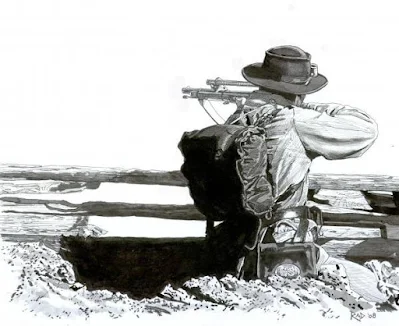Born on November 11, 1846, young James Daniel Faires of York, South Carolina was just a farm boy of 17 years when he joined the Catawba Light Infantry, Company H, 18th South Carolina Infantry in August of 1864 -- less than a year before the bloody War Between The States would formally end.
Faires joined his new regiment along with General Robert E. Lee's Army of Northern Virginia during the nine-month-long Siege of Petersburg, Virginia (June 15, 1864 - April 2, 1865) where the young recruit would soon be introduced to the horrors of prolonged trench warfare.
Just over two months there, Faires received his first wound, being shot in the chest and sent to Jackson Hospital in Richmond. He soon recovered and rejoined the 18th S.C. where he would again be wounded in the trenches before Petersburg with a gunshot wound to the face in March of 1865.
Young Faires would again return to his regiment just as Petersburg fell and arrived in time for the Battle of Five Forks (April 1, 1865) where the regiment left the trenches with Major General George E. Pickett’s
Division to defend a vital crossroads southwest of Petersburg from the
combined forces of Major General Gouverneur K. Warren’s 5th Corps and Phillip Sheridan’s Cavalry Corps. Outnumbered and eventually outflanked, the Confederates fought hard, but were ultimately overwhelmed. As a result, Lee’s
Army was soon forced to abandon Petersburg and
Richmond the next day and retreat west towards Appomattox Court House where Lee would surrender to Lieutenant General U.S. Grant just over a week later.
 |
| The grave of Pvt. James D. Faires at Christian Cemetery in Nacogdoches, Texas. |
It was during the battle that Faires was shot for the third, and final time, receiving a ghastly bullet wound in the head that nearly split his skull open. He would be captured along with over 2,000 other Confederate soldiers that day.
The wounded Faires was sent to Lincoln General Hospital in Washington City where Union Surgeon J.C. McKee would remove shattered bone fragments from his skull and replaced with a steel plate on April 20th.
After signing his Oath of Allegiance to the Union in June 1865, Faires was released from the hospital and walked home from Virginia. He returned to his family farm and then later married his wife, Martha Jane Campbell, in 1878 and started his own family farm at Steele Creek, North Carolina where they would live for a time before moving to Nacogdoches, Texas. He and Martha would eventually have six children.
Faires would continue to suffer the painful effects of his final wound his whole life with off and on headaches. By 1910, the then 63 year old Confederate veteran would go blind.
He died on June 5, 1914 at the age of 67 and is buried in Christian Cemetery in Nacogdoches with his wife and other family members.

Sketch by Alfred Waud, "Last Stand of Pickett’s Men" at the Battle of Five Forks (April 1, 1865)










